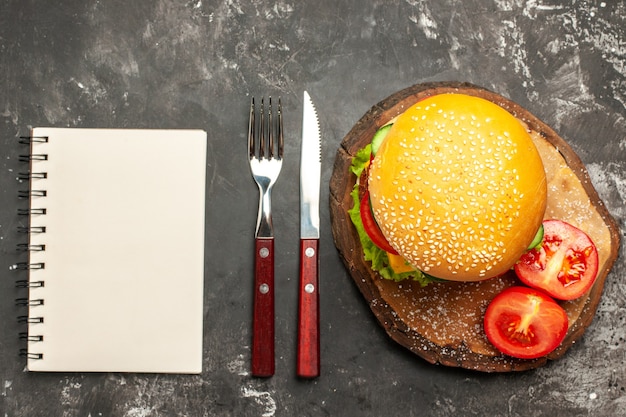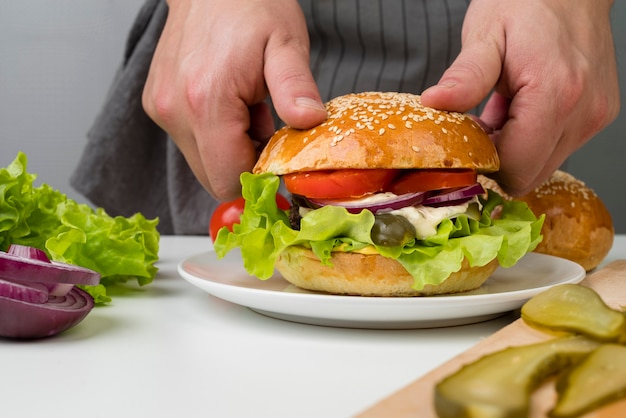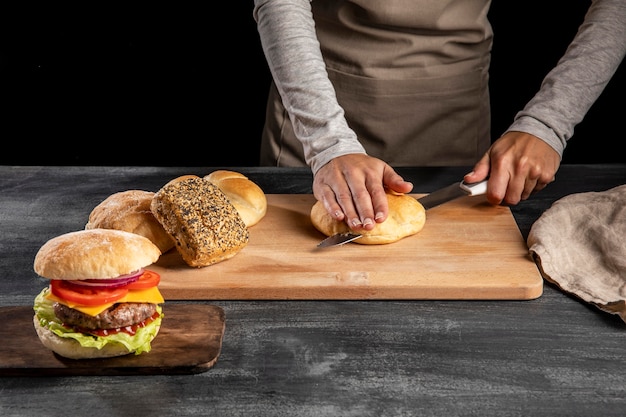Ah, the burger. A culinary icon, a symbol of summer barbecues, and a delicious comfort food enjoyed by millions. But let's face it, there's nothing more disappointing than a burger that's overcooked and dry, or worse, still pink in the middle. It's a culinary conundrum, but fear not! I've spent countless hours – and, yes, eaten many a questionable burger – perfecting the art of burger cookery. And trust me, you don't need to be a grill master to get it right. With the right techniques, a little patience, and a dash of confidence, you can be flipping juicy, flavour-packed patties like a seasoned pro.
(Part 1) The burger patty: Your Culinary Canvas

The burger patty is the heart and soul of your creation, the foundation on which your burger dreams are built. While you can certainly buy pre-made patties, there's a special satisfaction in crafting your own. It's an opportunity to control the ingredients, ensure quality, and shape them to perfection. This is where you truly become the artist, and the patty becomes your canvas.
Choosing the Right Meat: A Flavorful Foundation
Let's start with the basics: the meat. While ground beef reigns supreme in the classic burger, don't be afraid to experiment. Ground turkey, lamb, or even a blend of different meats can add unique flavours and textures. Personally, I'm a big fan of a blend of 80% lean beef and 20% fat. This gives you a burger that's juicy and flavourful without being overly greasy. It's a balance that yields a truly satisfying bite.
Seasoning with Finesse: Enhancing the Natural Flavor
Salt and pepper are the burger's best friends, the duo that elevates its natural flavour. A light sprinkle on both sides before cooking is all you need, but don't be shy. A generous pinch allows the seasoning to penetrate the meat, creating a delicious crust. If you want to add a little flair, consider adding garlic powder, onion powder, or paprika, but use them sparingly. Too many spices can overwhelm the beautiful beefiness of the patty.
Forming the Perfect Patty: A Culinary Symphony
Now, for the artistry. Don't overwork the meat. Gently shape it into a patty about 1/2-inch thick, ensuring the centre is slightly thicker than the edges. This helps prevent the patty from puffing up during cooking, creating an even, beautifully cooked burger. Pro tip: Make a slight indent in the centre of the patty. This helps the burger cook evenly and prevents it from developing an undesirable "dome" shape, ensuring a more aesthetically pleasing presentation.
(Part 2) Grilling: Embracing the Flames

Ah, the grill. There's something primal, almost magical, about cooking over an open fire. The smoky aroma, the sizzling sounds, the anticipation – it's a sensory experience that elevates the burger to a whole new level. But like any culinary adventure, there are techniques to master, secrets to uncover.
Preheating: A Culinary Essential
Don't rush into things. A hot grill is essential for creating those beautiful grill marks and ensuring a juicy, well-cooked burger. Give your grill ample time to heat up. For gas grills, aim for medium-high heat (around 400°F). For charcoal grills, a combination of hot and cooler coals will allow for direct and indirect cooking, achieving the perfect balance of flavour and tenderness.
Grill Marks: A Mark of Mastery
Grill marks are more than just aesthetics. They're a sign of a properly cooked burger, showcasing the mastery of the grilling process. To achieve those perfect criss-cross patterns, place your patties on the grill at a 90-degree angle. Let them cook for 2-3 minutes per side before rotating them 90 degrees. This ensures even cooking and creates those iconic, visually appealing grill marks.
The Flip: A Moment of Truth
Ah, the flip. This is a moment of anticipation, a testament to your grilling skills. You want to make sure the patty is nicely browned on the first side before flipping it over. Use a spatula to gently lift the edge of the patty. If it releases easily and doesn't stick to the grill, it's ready to flip. This ensures a beautifully browned exterior and a juicy, well-cooked interior.
(Part 3) Pan-Frying: The Indoor Solution

Not everyone has the luxury of a grill, and that's perfectly fine. Pan-frying offers a convenient and equally delicious alternative, allowing you to achieve those juicy, flavour-packed burgers right on your stovetop. It's a simple technique that can yield remarkable results.
Choosing the Right Pan: The Foundation of Flavor
A cast-iron pan is a classic choice for pan-frying burgers. It heats evenly and retains heat well, ensuring a crispy, well-cooked patty. If you don't have a cast-iron pan, a heavy-bottomed skillet will work just fine. The key is to ensure even heat distribution for a consistently cooked burger.
Grease is the Word: Adding a Luscious Touch
Just like with grilling, a little grease is essential to prevent the burger from sticking to the pan. I usually use a neutral oil like canola or vegetable oil. Heat the oil over medium-high heat before adding the patties. This creates a layer that facilitates browning and prevents sticking, resulting in a beautiful, evenly cooked burger.
Don't Overcrowd the Pan: Space for Flavor
This is a common mistake that can lead to uneven cooking and a less than stellar burger. Give each patty ample space to cook. If your pan is too small, cook the patties in batches to prevent overcrowding. This ensures that the heat reaches all sides of the patty evenly, resulting in a perfectly cooked burger.
(Part 4) The meat thermometer: Your Culinary Compass
Now, let's talk about the most important tool in your burger arsenal: the meat thermometer. It's your culinary compass, ensuring a safe and delicious burger every time. No more guessing, no more fear of undercooked meat. A few seconds with a thermometer can make all the difference, guiding you towards a truly perfect burger.
The Magic Number: 160°F
The USDA recommends cooking beef to an internal temperature of 160°F to ensure it's safe to eat. Now, I understand that some people enjoy their burgers a little more pink. But if you're unsure, always err on the side of caution and cook it to 160°F. It's better to be safe than sorry, especially when it comes to food safety.
How to Use a Meat Thermometer: A Quick Guide
Insert the thermometer into the thickest part of the patty, making sure it doesn't touch bone or fat. Leave it in for a few seconds until the temperature reading stabilizes. You're looking for a reading of 160°F for a well-done burger. This ensures that the burger is cooked through, eliminating any potential food safety concerns.
Don't Forget to Rest: Releasing the Flavors
After you've cooked your burger to the desired temperature, let it rest for a few minutes before serving. This allows the juices to redistribute throughout the patty, resulting in a more flavorful and juicy burger. It's a simple step that makes a significant difference in the overall quality and taste of your burger.
(Part 5) Cook Times: A Handy Guide
Now, let's get to the heart of the matter: the cook times. Here's a general guide based on the thickness of your burger patties. Remember, these are just estimates. The actual cook time will vary depending on the heat of your grill or pan, the thickness of the patty, and your personal preference for doneness. It's always a good idea to use a meat thermometer to ensure your burger is cooked to your liking.
| Patty Thickness | Grill Time (Per Side) | Pan-Fry Time (Per Side) |
|---|---|---|
| 1/2-inch | 3-4 minutes | 3-4 minutes |
| 3/4-inch | 4-5 minutes | 4-5 minutes |
| 1-inch | 5-6 minutes | 5-6 minutes |
(Part 6) Doneness Levels: Navigating the Spectrum of Taste
The level of doneness you prefer is a matter of personal taste. Some prefer a juicy, rare burger, while others prefer a well-done patty. It's all about personal preference. Here's a breakdown of the different levels and their corresponding internal temperatures. This will help you understand the different levels of doneness and choose the one that best suits your taste.
- Rare: 125°F - 130°F. The patty is red in the centre, with a cool pink tinge. This is for those who enjoy their burgers with a slight red centre, appreciating the raw, uncooked texture.
- Medium-Rare: 130°F - 135°F. The patty is pink in the centre, with a slightly firmer texture. This is a popular choice for many burger enthusiasts, striking a balance between doneness and juiciness.
- Medium: 135°F - 140°F. The patty is a light brown throughout, with a pink tinge in the centre. This is a good choice for those who prefer a more cooked burger but still enjoy a touch of pink in the middle.
- Well-Done: 160°F. The patty is cooked all the way through, with a brown exterior and a brown interior. This is the safest option, ensuring the patty is fully cooked. It's a good choice for those who prefer a well-cooked burger with a consistent texture throughout.
(Part 7) Finishing Touches: Elevate Your Burger
You've got your perfect patty, beautifully cooked to your liking. Now, it's time to dress it up for the ultimate burger experience. Think of this as the final act, where you add the finishing touches that will take your burger from good to great.
The Bun: The Perfect Cradle for Your Burger
The bun is the foundation for your burger, the cradle that holds your culinary masterpiece. I prefer a soft, fluffy bun that can hold up to all the toppings. Toasting the bun before adding the patty is a must. It adds a nice crispy texture and prevents the bun from getting soggy, ensuring a delightful textural experience with every bite.
Toppings: A Symphony of Flavors
The toppings are where you can really get creative. Classic choices include lettuce, tomato, onion, pickles, and cheese. But don't be afraid to experiment with other options. I'm a big fan of adding bacon, avocado, grilled pineapple, or even a fried egg. The possibilities are endless! The key is to create a symphony of flavours that complement your burger and delight your taste buds.
Sauce: The Finishing Touch
A good burger sauce can really elevate the taste. Classic choices include ketchup, mustard, mayonnaise, and barbecue sauce. But I'm also a big fan of homemade sauces. Try adding a dollop of remoulade, aioli, or even a spicy sriracha mayo. The sauce is the final touch, adding a burst of flavour and a touch of complexity to your burger, making it truly unforgettable.
(Part 8) FAQs: Your Burger Queries Answered
You've got your burger basics down, but maybe some questions are still swirling in your mind. Let's tackle them head-on, providing clear and concise answers to common burger-related queries.
Q: What if my burger is too thin?
A: If your burger is too thin, it's going to cook quickly and might end up dry. You can try adding a few more patties together to create a thicker patty. Alternatively, you can cook it for a shorter time. Remember to use a meat thermometer to ensure it reaches your desired doneness. Don't be afraid to experiment to find the perfect balance of thickness and cook time for your thin patty.
Q: How long can I cook my burger on the grill before I need to flip it?
A: A good rule of thumb is to cook the patty for 2-3 minutes per side before flipping. You want to ensure that the patty is nicely browned on the first side before flipping it over. If it sticks to the grill, it's not ready to flip. Patience is key, and allowing the patty to develop a beautiful crust will result in a more flavorful and delicious burger.
Q: My burger is burning on the outside and raw in the middle. What's going on?
A: This usually happens when you're cooking over too high heat. Turn down the heat or move the patty to a cooler part of the grill. You can also try cooking the patty for a shorter amount of time. Remember, patience is key! Adjusting the heat and cook time will ensure a perfectly cooked burger, with a delicious crust and a juicy interior.
Q: Can I use frozen burger patties?
A: Absolutely! Just make sure to thaw the patties in the refrigerator overnight before cooking. Frozen patties will take a bit longer to cook, so add a few minutes to your cook time. It's also a good idea to use a meat thermometer to ensure the burger is cooked through. Thawed frozen patties can be cooked just like fresh patties, resulting in a delicious and satisfying burger experience.
Q: What are some tips for making a juicy burger?
A: Here are a few tips to ensure a juicy, flavorful burger every time:
- Use ground beef that's at least 80% lean. This balance of fat and lean ensures a juicy, flavorful patty.
- Don't overwork the meat when forming the patties. Gentle handling preserves the natural tenderness of the meat.
- Make sure the grill or pan is hot before adding the patties. High heat sears the exterior, creating a flavorful crust and locking in the juices.
- Cook the patties over medium-high heat. This ensures even cooking and a delicious crust.
- Use a meat thermometer to ensure the burger is cooked to your liking. This guarantees a safe and perfectly cooked burger.
- Let the burger rest for a few minutes before serving. This allows the juices to redistribute, resulting in a more flavorful and juicy burger.
Remember, the perfect burger is all about finding the right balance of flavor, texture, and doneness. With a little practice and a dash of confidence, you can create a burger that will impress your friends and family. So, get grilling, get pan-frying, and enjoy the deliciousness that is the perfect burger!
Everyone is watching

Corn on the Cob: The Ultimate Guide to Perfectly Cooked Ears
Healthy MealsAh, corn on the cob. Just the name evokes images of sunny days, barbecues, and that sweet, juicy flavour that ...

Scallops: The Ultimate Guide to Perfect Cooking
Healthy MealsAh, scallops. Those delicate, sweet, and utterly delicious morsels of the sea. They hold a special place in my...

Spaghetti Squash: The Ultimate Guide to Cooking and Serving
Healthy MealsRemember that time you saw spaghetti squash at the supermarket, looking all bumpy and strange, and thought, "W...

Salmon Cooking Times: Perfect Guide for Every Recipe
Healthy MealsLet me tell you, cooking salmon is an art form. It's all about getting that perfect balance: juicy and tender,...

Ham Cooking Time: How Long to Bake, Smoke, or Boil a Delicious Ham
Healthy MealsAh, ham. It's a classic, isn't it? A real crowd-pleaser, especially around holidays. And when done right, it'...
